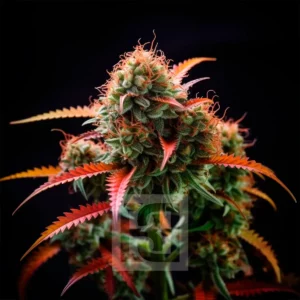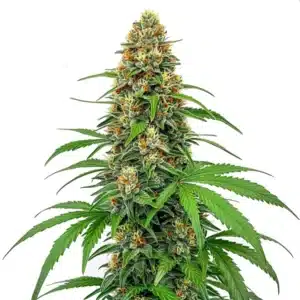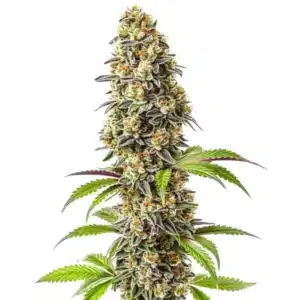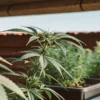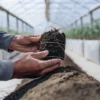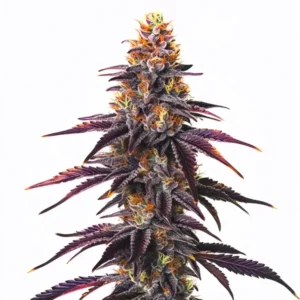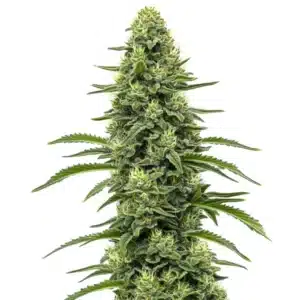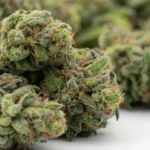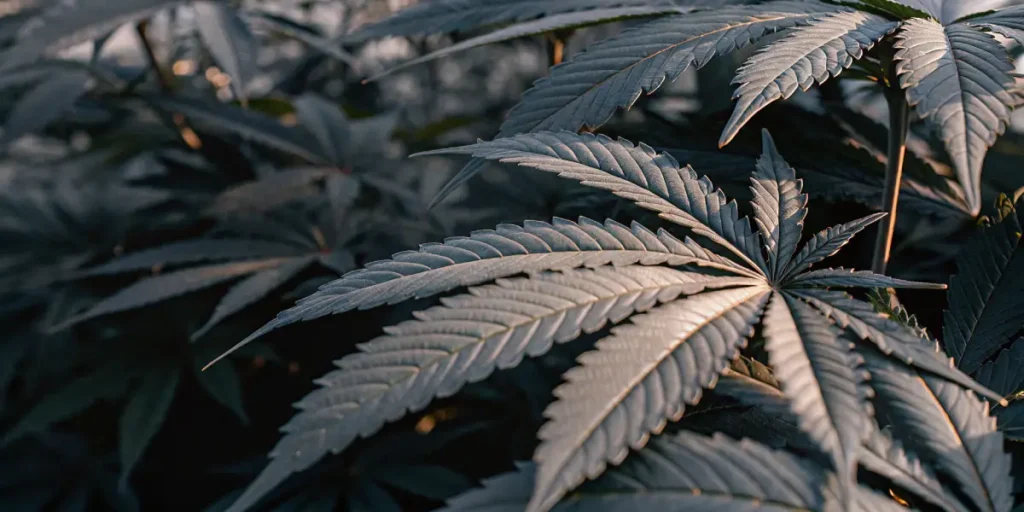
Photoreceptors and Stretching in Cannabis Plants
Photoreceptors hold a significant impact on cannabis growth, influencing how plants respond to light. These tiny molecules in plant cells sense light and trigger various growth responses. When photoreceptors detect insufficient light, cannabis plants may stretch, elongating their stems in search of more light. This stretching can result in weak stems and lower yields.
Stretching in cannabis plants often occurs when the photoreceptors signal a need for more light. This is a natural process, but in controlled environments like indoor grows, it can be managed. By knowing how photoreceptors work, growers can adjust light cycles and intensities to optimize cannabis development.
Recommended Strains
Successful cannabis cultivation involves managing the balance of light to prevent unwanted stretching. Growers can use this knowledge to improve plant structure and maximize yields. Through careful manipulation of light conditions, photoreceptor impact on cannabis growth can be harnessed for better results.
Cannabis Photoreceptors and Light Cycles
Cannabis photoreceptors play a crucial role in how plants perceive and use light. These receptors are sensitive to different light wavelengths, each affecting plant growth in unique ways. Blue light, for instance, is critical for vegetative growth, while red light is essential during the flowering stage.
Light cycles are equally important in cannabis cultivation. By controlling the duration and intensity of light exposure, growers can influence photoreceptor activity. This leads to healthier plants and higher yields. For first-time growers, knowing light cycles can make the difference between a successful and a disappointing harvest.
The photoreceptor impact on cannabis growth is profound, shaping how plants adapt to their light environment. By leveraging this knowledge, growers can fine-tune their setups to cater to specific growth goals. This ensures that the plants not only survive but thrive under optimal conditions.
Knowing cannabis photoreceptors and light cycles is crucial for developing strategies that prevent stretching. By aligning the light conditions with the natural needs of the plant, growers can maintain balanced growth. This minimizes the risks associated with excessive elongation and supports robust development throughout the plant’s life cycle.
Managing Light for Optimal Growth
Adjusting light cycles to the specific needs of cannabis plants helps prevent stretching. During the vegetative stage, a cycle of 18 hours of light and 6 hours of darkness is ideal. This ensures that photoreceptors are activated optimally, promoting robust growth without excessive stretching.
As the plants transition to the flowering stage, switching to a 12/12 light cycle can be beneficial. This encourages the plants to focus on bud development rather than elongating their stems. By carefully managing these cycles, the photoreceptor role in cannabis development can be optimized.
Implementing proper light management strategies is key to achieving high-quality yields. By ensuring that the light spectrum and duration are tailored to the plant’s growth stage, growers can enhance the plant’s natural abilities. This results in a more efficient cultivation process, reducing waste and maximizing output.
For experienced growers, knowing the nuances of light management can lead to innovative cultivation techniques. Exploring different light spectrums and their effects on photoreceptor activity opens up new possibilities for optimizing growth. This knowledge empowers growers to push the boundaries of what is possible in cannabis cultivation.
Promos & Deals
Stretching Prevention in Cannabis Cultivation
Stretching prevention is a key concern for many cannabis growers. Excessive stretching can lead to weak, spindly plants that are prone to breaking and produce lower yields. To combat this, knowing and manipulating light exposure is crucial.
One effective strategy is to provide ample light intensity, ensuring that photoreceptors receive the signals needed to promote bushier, more compact growth. This involves using lights that emit the correct spectrum and positioning them at the right distance from the plant canopy.
Stretching prevention in cannabis cultivation requires a proactive approach. Growers must consistently monitor their plants and adjust environmental factors to maintain optimal conditions. This vigilance helps prevent the onset of stretching and supports the development of strong, resilient plants.
By integrating technology into the cultivation process, growers can enhance their ability to prevent stretching. Automated systems for light and environmental control provide real-time data, allowing for precise adjustments. This technological edge ensures that cultivation practices are always aligned with the plant’s needs.
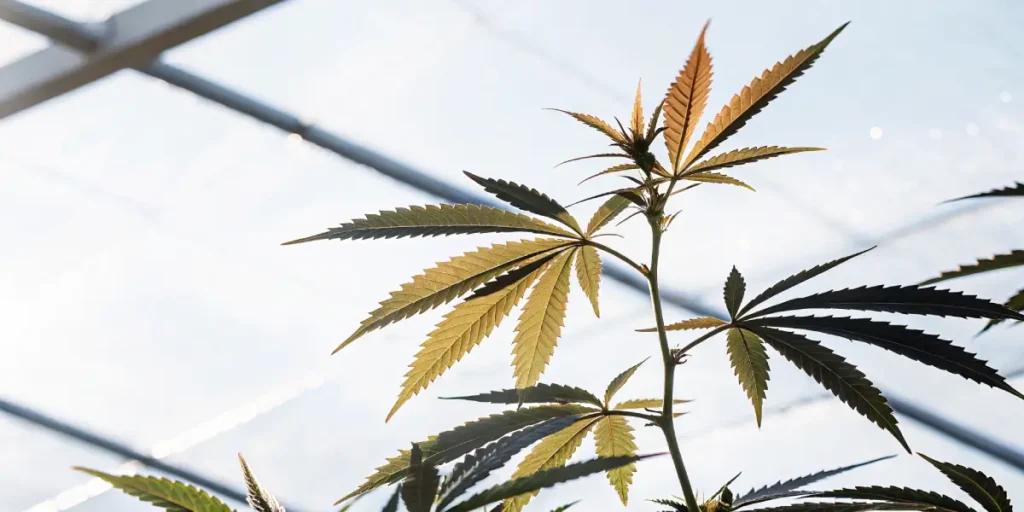
Practical Solutions to Combat Stretching
Regular monitoring and adjusting of light sources can significantly reduce stretching. Keeping lights close to the plants without causing heat stress ensures that photoreceptors are triggered to encourage dense growth. Strains such as Gelato thrive under such conditions, producing compact, resinous buds.
Additionally, using reflective materials in the grow space can help maximize light availability. This ensures that all parts of the plant receive adequate light, preventing photoreceptors from signaling the need to stretch. Growers can also employ low-stress training (LST) techniques to physically manipulate plant growth.
Practical solutions to combat stretching are essential for maintaining plant health and achieving desirable yields. Techniques like pruning and topping can be employed to manage plant height and encourage lateral growth. These methods complement light management strategies, providing a holistic approach to cultivation.
Innovative training techniques, such as the Screen of Green (SCROG) method, can further optimize plant structure. By spreading out the canopy, growers ensure even light distribution, enhancing the photoreceptor impact on cannabis growth. These approaches result in a more efficient use of space and resources.
Cannabis Plant Stretching Solutions
Combating cannabis plant stretching involves a multifaceted approach. Beyond adjusting light, environmental factors such as temperature and humidity also play a role. Keeping these factors in balance supports optimal photoreceptor function, reducing the likelihood of unwanted stretching.
Creating a stable environment is key. This means maintaining consistent temperatures and humidity levels that align with the specific needs of the cannabis strain being grown. Knowing these requirements can prevent photoreceptors from being overstimulated, which can lead to stretching.
Effective cannabis plant stretching solutions require a combination of techniques tailored to the specific needs of the grow. By integrating environmental controls with strategic light management, growers can create a supportive environment for plant development. This holistic approach minimizes the risk of unwanted growth patterns.
Exploring new technologies and cultivation practices can offer additional solutions to stretching. Innovations in light technology, such as LED advancements, provide more efficient options for managing light exposure. These developments support the goal of maintaining compact, productive plants through optimized photoreceptor activity.
Environmental Control for Better Growth
Using fans and ventilation systems to manage airflow is one practical method for controlling the environment. Good air circulation prevents hot spots and ensures even distribution of temperature and humidity. This creates a comfortable environment for cannabis plants to thrive.
Strains like Gorilla Glue #4 are known for their resilience but can still benefit from a well-maintained environment. By ensuring optimal conditions, growers can enhance the natural characteristics of the strain and reduce the risk of stretching.
Environmental control for better growth involves knowing the specific needs of each cannabis strain. By tailoring the environment to these requirements, growers can enhance the photoreceptor role in cannabis development. This leads to healthier plants with improved growth characteristics.
Advanced environmental control systems provide precision in maintaining the ideal growing conditions. These systems automate the regulation of temperature, humidity, and airflow, allowing for consistent optimization of the growing environment. This technological integration supports the cultivation of high-quality cannabis with minimal risk of stretching.

FAQs
What are photoreceptors in cannabis plants?
Photoreceptors in cannabis plants are specialized proteins that detect light. They play a crucial role in how plants grow and develop, influencing various processes like photosynthesis and flowering. When these receptors sense specific wavelengths of light, they trigger responses that affect growth patterns.
For cannabis, the main types of photoreceptors include phytochromes and cryptochromes. These are sensitive to red and blue light, respectively, and are vital for managing the plant’s life cycle. Knowing how they work helps growers create optimal conditions for their plants.
The study of photoreceptors and stretching in cannabis plants reveals the intricate relationship between light exposure and plant development. By focusing on these key elements, growers can enhance their cultivation strategies, ensuring robust plant health and maximizing yield potential.
Delving deeper into photoreceptor mechanisms can provide insights into new cultivation techniques. By harnessing the power of these proteins, growers can explore new methods for optimizing growth, reducing energy consumption, and improving overall plant quality.
Why do cannabis plants stretch?
Stretching in cannabis plants is often a response to inadequate light. When photoreceptors detect low light levels, they trigger the plant to grow taller in search of more light. This is a natural survival mechanism but can lead to undesirable growth in controlled environments.
To prevent this, growers can adjust light intensity and cycles to ensure plants receive enough light. This helps maintain a compact, bushy structure and avoids the issues associated with excessive stretching, such as weak stems and reduced yields.
Knowing the reasons behind cannabis plant stretching is crucial for developing effective cultivation practices. By identifying the triggers for stretching, growers can implement strategies that mitigate these effects, ensuring a more stable and productive growing environment.
Addressing the underlying causes of stretching also involves considering other environmental factors. By maintaining optimal conditions, including proper light exposure, growers can reduce the likelihood of stretching, supporting healthier plant development and better yield outcomes.
How can I prevent cannabis plant stretching?
Preventing cannabis plant stretching involves managing light, temperature, and humidity. Ensuring the right light intensity and spectrum is crucial, as this directly influences photoreceptor activity. Positioning lights closer to the canopy without causing heat stress can also help.
Environmental control is equally important. Keeping temperatures and humidity levels stable supports healthy growth and minimizes the risk of stretching. Using tools like fans and ventilation systems can help create an ideal growing environment.
Implementing a comprehensive strategy for preventing cannabis plant stretching can lead to significant improvements in plant health and yield. By focusing on both light management and environmental controls, growers can create conditions that naturally discourage excessive elongation.
Integrating regular monitoring practices into the cultivation routine can further aid in stretching prevention. By continuously assessing plant health and environmental conditions, growers can make informed adjustments that support optimal growth and development.
What strains are less prone to stretching?
Some cannabis strains are naturally more compact and less prone to stretching. For example, Gelato is known for its dense, bushy growth. These strains often require less intervention to prevent stretching.
Choosing strains that suit your growing environment can simplify the cultivation process. By selecting strains with growth patterns that align with your setup, you can reduce the need for extensive light and environmental adjustments.
Identifying strains that exhibit reduced stretching tendencies can streamline cultivation efforts. By focusing on these naturally compact varieties, growers can achieve desirable results with less manipulation, leading to more efficient and rewarding growing experiences.
Exploring the genetic traits of different strains can provide valuable insights into their growth habits. By knowing the inherent characteristics of each variety, growers can make informed decisions that align with their cultivation goals and environmental conditions.
Can stretching affect cannabis yield?
Yes, stretching can negatively impact cannabis yield. When plants stretch excessively, they often develop weaker stems that struggle to support heavy buds. This can lead to breakage and reduced overall yield.
To maximize yield, it’s important to manage stretching by providing adequate light and maintaining stable environmental conditions. This ensures that plants develop strong structures capable of supporting high-quality bud production.
Stretching can also affect the overall quality of cannabis plants, as it may lead to uneven bud development and reduced cannabinoid concentration. By preventing excessive elongation, growers can enhance the potency and overall appeal of their harvest.
Implementing effective stretching prevention techniques contributes to a more consistent and reliable yield. By ensuring that plants remain structurally sound throughout their growth cycle, growers can optimize the quality and quantity of their final product.




